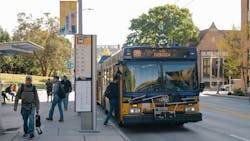Seattle Mayor Harrell unveils $1.35 billion transportation levy
On April 4, Seattle, Wash., Mayor Bruce Harrell unveiled a eight-year, $1.35 billion transportation levy proposal draft for public input. The proposal recommends more funding to repair bridges, repave streets, connect neighborhoods to light rail, build sidewalks and make getting around Seattle safer.
“Seattle residents want a transportation system that is safe, connected and well-maintained. This levy proposal will deliver more funding to get us there. No matter how you get around, it will make trips safer, more reliable and better connected so that every Seattleite is set up for success when they experience our city. This is a top priority and will allow our transportation department to keep taking care of the essentials, be proactive stewards of our public assets and keep the city working for you,” said Mayor Harrell.
“The mayor’s levy proposal offers a balanced and practical set of investments to maintain and modernize our streets and bridges. Informed by the Seattle Transportation Plan, our Asset Management Strategy and our strengthened Vision Zero program, this major program of investments will produce a safer, better connected and more reliable transportation system for all,” said Greg Spotts, director, Seattle Department of Transportation (SDOT)
The proposal includes the total levy size, spending amounts for each SDOT program and details about the major capital project candidates.
Proposed program spending
- $423 million to repave and improve streets that carry the most buses, trucks and cars and make it safer for everyone to walk, roll, bike and ride transit.
- $218 million to keep bridges in good and reliable working condition and prepare for future bridge projects.
- $121 million to connect people safely to transit hubs, including Link light-rail stations; improve bus stops and reduce delays on bus routes.
- $109 million to build and repair sidewalks, crossings and curb ramps
- $107 million to reduce traffic collisions, severe injuries, and fatalities through targeted improvements to streets, sidewalks, intersections, paths and crossings.
- $100 million to Install new and maintain and upgrade traffic signals for safe, reliable movement; improve pedestrian and bike accessibility and support traffic operations during large events and for trips in and out of the port.
- $94 million to expand Seattle’s protected bike lane network; connect schools to bike lanes, paths and neighborhood greenways and maintain and upgrade existing bike lanes.
- $57 million to make public spaces more inviting and improve lighting so people can enjoy unique and vibrant neighborhoods and business districts.
- $49 million to address climate change directly, reducing air pollution and making sustainable transportation options more available.
Features of the proposal
- Increasing funding for SDOT's Vision Zero program using a Safe System approach.
- Supporting construction of 250 blocks of new sidewalks.
- Installing head-start pedestrian walk signals at 280 intersections.
- Contributing to 10,000 new ADA-accessible curb ramps.
- Implementing safety projects on 12 or more corridors that have the highest number of crashes.
- Upgrading 30 percent of existing protected bike lanes with better barriers.
- Improving walking and biking connections and lighting to public schools and light-rail stations.
- Improving the bike network by increasing protection, enhancing maintenance and closing gaps.
- Launching a new preventative bridge maintenance program to make the right treatments at the right time and extend the life of the bridges.
- Repairing 34,000 urgent sidewalk defects and replacing sidewalks.
- Repaving at least 15 of Seattle’s busiest streets, improving them for people to walk, roll, bike, and take transit.
- Updating signal timing on 40 corridors.
- Installing new traffic signals that improve flow and safety for people and goods.
- Making improvements on five of the most delayed transit routes.
- Upgrading two busy bus routes in equity priority areas.
- Adding 2 east-west transit corridors providing access to light-rail stations.
- Building 160 projects that improve transit reliability, equity and safety.
“Transit links people to jobs, housing and all the opportunities the Seattle area has to offer. With investments that make it easier and safer for more people to use transit, the city is a key partner with Sound Transit in helping to create a more connected, more productive region for all of us,” said Goran Sparrman, Sound Transit interim CEO.
